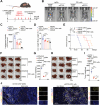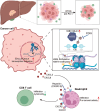Targeting Deltex E3 Ubiquitin Ligase 2 Inhibits Tumor-associated Neutrophils and Sensitizes Hepatocellular Carcinoma Cells to Immunotherapy
- PMID: 39733452
- PMCID: PMC11831464
- DOI: 10.1002/advs.202408233
Targeting Deltex E3 Ubiquitin Ligase 2 Inhibits Tumor-associated Neutrophils and Sensitizes Hepatocellular Carcinoma Cells to Immunotherapy
Abstract
Several E3 ligases have been found to affect the immune microenvironment of hepatocellular carcinoma (HCC) and lead to the resistance of immunotherapy. In this study, genes of E3 ligases are screened based on The Cancer Genome Atlas (TCGA) dataset. Through cytometry by time of flight (CyTOF), flow cytometry, and further experiments, Deltex E3 ubiquitin ligase 2 (DTX2) in HCC cells is identified to promote the infiltration and polarization of tumor-associated neutrophils (TANs) with a protumor phenotype, thus attenuating the infiltration and cytotoxicity of CD8+ T cells partially through C-X-C motif chemokine 2 (CXCL2) and C-X-C motif chemokine 6 (CXCL6). Mechanistically, DTX2 can interact with histone H2B and promote its monoubiquitination at lysine120 (H2BK120ub1), thereby increasing CXCL2 and CXCL6 transcription through histone epigenetic regulation. Different tumor models in vivo demonstrated that DTX2 inhibitor treatment inhibited tumor growth and sensitized HCC cells to the therapeutic effects of programmed cell death protein 1 (PD-1) antibody. In summary, this study identifies DTX2 as a potential target for HCC immunotherapy.
Keywords: DTX2 inhibitor; deltex E3 ubiquitin ligase 2; hepatocellular carcinoma; tumor‐associated neutrophils.
© 2024 The Author(s). Advanced Science published by Wiley‐VCH GmbH.
Conflict of interest statement
The authors declare no conflict of interest.
Figures








Similar articles
-
Role and therapeutic potential of E3s in the tumor microenvironment of hepatocellular carcinoma.Front Immunol. 2024 Oct 31;15:1483721. doi: 10.3389/fimmu.2024.1483721. eCollection 2024. Front Immunol. 2024. PMID: 39544935 Free PMC article. Review.
-
DTX2 attenuates Lenvatinib-induced ferroptosis by suppressing docosahexaenoic acid biosynthesis through HSD17B4-dependent peroxisomal β-oxidation in hepatocellular carcinoma.Drug Resist Updat. 2025 Jul;81:101224. doi: 10.1016/j.drup.2025.101224. Epub 2025 Feb 28. Drug Resist Updat. 2025. PMID: 40058099
-
BIRC2 blockade facilitates immunotherapy of hepatocellular carcinoma.Mol Cancer. 2025 Apr 14;24(1):113. doi: 10.1186/s12943-025-02319-5. Mol Cancer. 2025. PMID: 40223121 Free PMC article.
-
CRKL dictates anti-PD-1 resistance by mediating tumor-associated neutrophil infiltration in hepatocellular carcinoma.J Hepatol. 2024 Jul;81(1):93-107. doi: 10.1016/j.jhep.2024.02.009. Epub 2024 Feb 23. J Hepatol. 2024. PMID: 38403027
-
Heterogeneity of tumor-associated neutrophils in hepatocellular carcinoma.Mol Immunol. 2025 Jan;177:1-16. doi: 10.1016/j.molimm.2024.11.009. Epub 2024 Dec 5. Mol Immunol. 2025. PMID: 39642781 Review.
Cited by
-
Unraveling the complex role of tumor-associated neutrophils within solid tumors.Cancer Immunol Immunother. 2025 May 19;74(7):210. doi: 10.1007/s00262-025-04049-5. Cancer Immunol Immunother. 2025. PMID: 40387965 Free PMC article. Review.
-
Silencing NEDD4L Effectively Inhibits the Malignant Behaviors of Hepatocellular Carcinoma.J Hepatocell Carcinoma. 2025 Jul 10;12:1369-1391. doi: 10.2147/JHC.S511466. eCollection 2025. J Hepatocell Carcinoma. 2025. PMID: 40661237 Free PMC article.
-
Ubiquitination in hepatocellular carcinoma immunity.J Transl Med. 2025 May 23;23(1):574. doi: 10.1186/s12967-025-06592-2. J Transl Med. 2025. PMID: 40410880 Free PMC article. Review.
References
MeSH terms
Substances
Grants and funding
- 82073217/National Natural Science Foundation of China
- 82073218/National Natural Science Foundation of China
- 82003084/National Natural Science Foundation of China
- 82273387/National Natural Science Foundation of China
- 82273386/National Natural Science Foundation of China
- 82403408/National Natural Science Foundation of China
- 82122051/National Natural Science Foundation of China
- 82073245/National Natural Science Foundation of China
- 2018SHZDZX05/Science and Technology Major Project
- 2019-I2M-5-058/CIFMS
- 2018YFC1312100/National Key R&D Program of China
- 2020YFE0202200/National Key R&D Program of China
- SHDC2020CR5007/Clinical Research Plan of SHDC
- 202040221/Shanghai Municipal Health Commission
- 2023ZYYS-011/Outstanding Resident Clinical Postdoctoral Program of Zhongshan Hospital Affiliated to Fudan University
LinkOut - more resources
Full Text Sources
Medical
Research Materials
